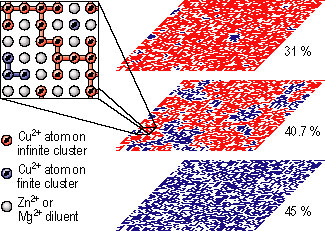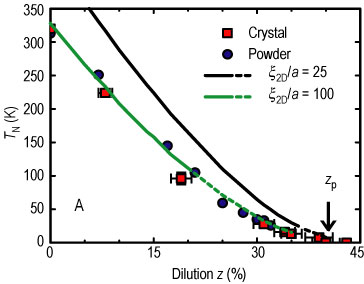A phase transition is the transformation of a system from one state to another, e.g. from an ordered phase to a disordered phase. In magnetic iron for example, the ordered ferromagnetic phase gives way to the disordered paramagnetic phase when fluctuations overwhelm the forces tending to order the system. In thermal phase transitions the amplitudes of these fluctuations increase with temperature, and the transition occurs at a “critical’’ temperature T sub C. By contrast, quantum phase transitions occur only at T = 0 K (Refer to reference 1). The relevant fluctuations are thus quantum mechanical in nature and can overwhelm the tendency to order when some other parameter of the system is varied. A conceptual example would be a ferromagnetic system at T = 0 that is continuously diluted with some non-magnetic material until it undergoes a transition to the paramagnetic state.
The hope for insight into the physics of high temperature superconductors has generated enormous interest in the case of the two-dimensional (2 D) spin one-half square-lattice Heisenberg antiferromagnet (S = one half S L H A F) because it models lanthanum sub 2, copper, oxygen sub 4, the parent compound of the first high-temperature superconductor. It has been theorized that a quantum phase transition might occur in lanthanum sub 2, copper, oxygen sub 4, by doping with static, non-magnetic, atoms (Refer to reference 2). We have investigated the properties of the 2 D, S = one half S L H A F using complementary neutron scattering and numerical simulations. Our results demonstrate that the spin-diluted Heisenberg antiferromagnet lanthanum sub 2, copper sub 1 minus z, (zinc or manganese) sub z, oxygen sub 4, is a prototype system for square-lattice site percolation in the extreme quantum limit of S = one half (Refer to reference 3). In the pure system (z = 0), magnetic copper 2 + ions form a 2 D square lattice dominated by an antiferromagnetic nearest-neighbor exchange mediated by intervening oxygen ions, which leads to long-range antiferromagnetic order at low temperature. Replacement of the copper spins with non-magnetic zinc 2 + and manganese 2 + ions randomly dilutes the antiferromagnetic sheets, weakening the antiferromagnetic order. With sufficient site dilution the system undergoes a geometric transition from having one infinite connected cluster of copper spins below the percolation threshold to only finite disconnected clusters above the percolation threshold (around 41 %), as shown in Figure 1. Our results demonstrate that random disorder and quantum fluctuations both play a strong role in determining the properties of this system near the percolation threshold.
 | Figure 1. A schematic of finite sections of the infinite lattice at dilution levels well below (31 %), just below (40.7 %), and above (45 %) the percolation threshold. Sites on the infinite cluster are shown in red, sites on finite disconnected clusters are blue, and diluents are in white. The inset is a close-up view for z = 40.7 %, showing the role that magnetic copper and non-magnetic zinc and manganese ions play in the experimental system. |
Previous experiments (Refer to reference 4) suggested that lanthanum sub 2, copper sub 1 minus z, (zinc or manganese) sub z, oxygen sub 4, might become disordered at zero temperature well below the classical percolation threshold because of quantum fluctuations. This question remained unresolved because of a lack of suitable samples, but high-quality single crystals of lanthanum sub 2, copper sub 1 minus z, (zinc or manganese) sub z, oxygen sub 4, grown at the T. H. Geballe Laboratory for Advanced Materials at Stanford University allowed us to solve this quantum percolation problem. Figure 2 shows the dilution dependence of the antiferromagnetic ordering (Néel) temperature T sub N. Although a purely 2 D system cannot have long-range order at nonzero temperature, small interlayer couplings allow long-range 3 D order to occur when the 2 D correlations become large enough. Monte Carlo calculations (also shown in Figure 2) indicate that this occurs at correlation lengths of around 100 lattice constants for both the pure and diluted systems. Our results for T sub N of (z) agree with previous measurements at lower concentrations (Refer to reference 4), but we find that at higher concentrations T sub N falls off more slowly and does not reach zero until the percolation threshold.

| Figure 2. Néel temperature phase diagram of lanthunum sub 2, copper sub 1 minus z, (zinc or manganese) sub z, oxygen sub 4. Single crystal results are from neutron diffraction, powder results are from S Q U I D Magnetometry. Lines are Monte Carlo results for the temperature at which spin-spin correlations reach the specified length. |
To study the 2 D static properties of lanthanum sub 2, copper sub 1 minus z, (zinc or manganese) sub z, oxygen sub 4, we measured the 2 D instantaneous spin-spin correlation length xi using a 2-axis energy-integrating technique in the paramagnetic phase above T sub N. The results are shown in Figure 3 (colored symbols) for a number of different concentrations and across a broad range of temperatures. Quantum Monte Carlo results for the nearest-neighbor Heisenberg model are shown as black symbols. There are no adjustable parameters in this comparison, and the experimental and Monte Carlo results match exceptionally well up to the percolation threshold. We can see that dilution not only weakens the correlations at a given temperature, but that it also slows down the rate at which they grow as the system is cooled. At low concentrations, xi scales exponentially in inverse temperature. Near the percolation threshold, however, xi exhibits power law behavior in inverse temperature, and above the percolation threshold it saturates at a finite length at low temperature.

| Figure 3. Spin-spin correlation length (in units of the lattice constant) versus inverse temperature (scaled by the nearest neighbor exchange energy J of the pure system) for different concentrations of non-magnetic ions. Colored symbols are experimental results, obtained from measurements of the static structure factor. Black filled symbols are quantum Monte Carlo results for z = (8, 20, 31, 35, 41, and 46) % dilution. Results for z = 0 % are from refernces 5 and 6. No adjustable parameters are used in the comparison. |
We have shown that lanthanum sub 2, copper sub 1 minus z, (zinc or manganese) sub z, oxygen sub 4, is an excellent model system for studying percolation in a 2 D S = one half Heisenberg antiferromagnet. A long-range-ordered ground state persists up to the percolation threshold even though quantum fluctuations increase as dilution is increased. Further studies of the dynamics will provide more insight into the role of disorder in this quantum many-body system.
References
[1] S. Sachdev, Quantum Phase Transitions, Cambridge University Press (Cambridge, 1999).
[2] Y.-C. Chen et al., Phys. Rev. B 61, R3772 (2000).
[3] O. P. Vajk et al., Science 295, 1691 (2002).
[4] M. Hücker et al., Phys. Rev. B 59, R725 (1999).
[5] R. J. Birgeneau et al., Phys. Rev. B 59, 13788 (1999).
[6] B. B. Beard et al., Phys. Rev. Lett. 80, 1742 (1998).
Authors
O. P. Vajk, P. K. Mang, and M. Greven
Stanford University
Stanford, CA 94305
P. M. Gehring and J. W. Lynn
NIST Center for Neutron Research
National Institute of Standards and Technology
Gaithersburg, MD 20899-8562
Back to FY2002 HTML main page
Go to next article
To view all symbols correctly, please download Internet Explorer 6 or Netscape 7.1